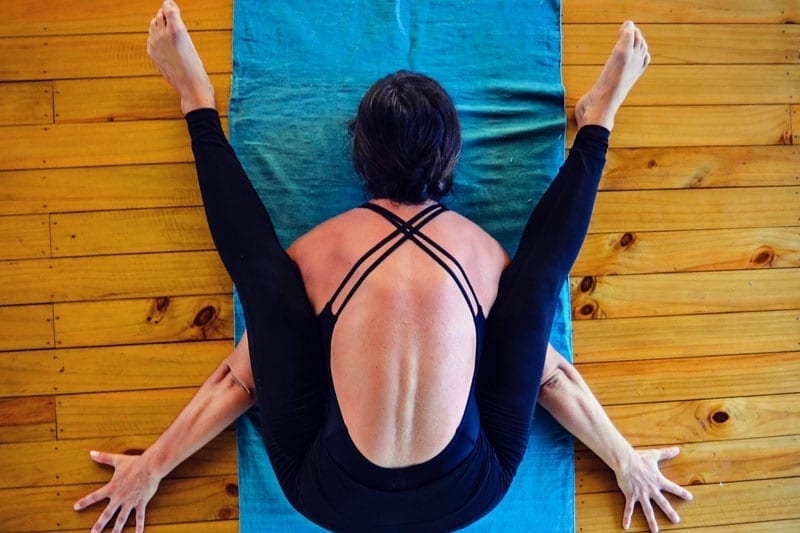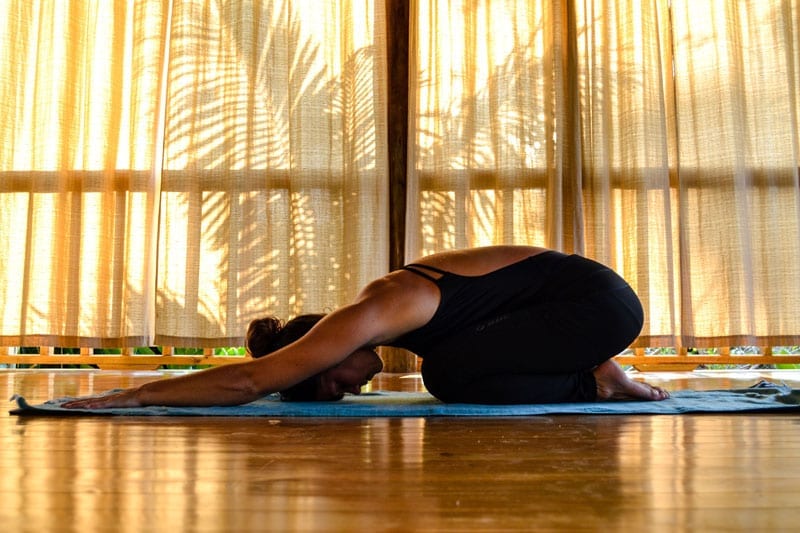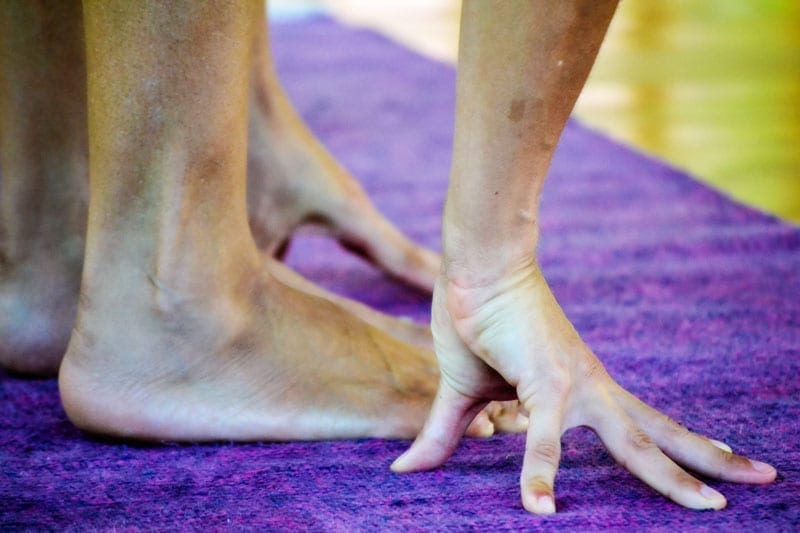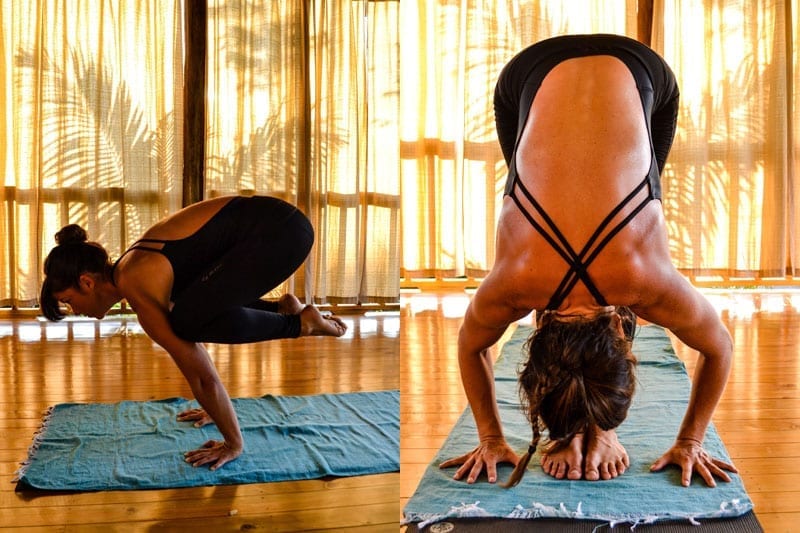This is part three of “Following the Eight-Limbed Path”, a series about Ashtanga yoga, read part two here
I roll out my mat when it’s still dark outside, the birds are still quiet, and so is my sleepy mind. My body feels inflexible after hours of sleep. I start breathing and move my body into the sun salutation sequence. With every movement and breath, it gets easier, lighter, and smoother. Slowly I am waking up my stiff body, showing it how to move, and synchronizing my breath with those movements. It’s like my mind is saying “Good morning, beautiful” to my body. Six times a week I wake up before sunrise to do my physical practice for almost two hours. I breathe, move, sweat, and struggle on the mat. You might wonder why I do that. What is the purpose of doing physical postures?

The benefits of repetition and discipline
The third limb of Ashtanga yoga is called asana, and it is the practice of physical postures. This is what we typically first get introduced to when starting a practice. Most of us start by taking a single yoga classes in which we do a lot of stretching, bending, and strengthening of the body. While our bodies are amazing tools and we should definitely use them as much as we can, moving the body into to different postures is actually not the ultimate goal of the yoga practice. The postures are just a tool to calm the mind and to move into the inner essence of being.
You see, yoga is more than just a physical practice. By opening up your body, you can eventually open up your mind, and the most fundamental goal of yoga is to quiet the mind. By constantly challenging yourself with different physical postures, you get the opportunity to explore and control all of your emotions. Asana has widespread benefits: improved health, strength, balance, and flexibility. But the deeper benefit that comes from a regular, daily practice is what keeps many doing this, day after day.

Yoga’s holistic nature
When your body starts to transform — opening up and gaining more strength — you are able to let go and soften. Often times, emotions that you have been keeping inside come up to the surface, and you are faced with your fears, sorrows, emotions, and things from our past that perhaps you have been unable to solve or resolve. At this point, you are not just working your body, you are also working your mind.
When practicing asanas on a regular basis, the first two limbs, yama and niyama will come more naturally. By working with your body, you become more aware of your surroundings as well as yourself. You will probably start to pay more attention to details and noticing how you react in different situations. Practicing asanas becomes both a preparation for meditation, and a meditation in and of itself. The postures become a tool to expand the consciousness, and the key to fostering this expansion begins with the control of breath: pranayama, the fourth limb.
This down-to-earth, flesh-and-bones practice is simply one of the most direct and expedient ways to meet yourself… This limb of yoga practice reattaches us to our body. In reattaching ourselves to our bodies we reattach ourselves to the responsibility of living a life guided by the undeniable wisdom of our body. — B.K.S. Iyengar

A personal practice
It is not uncommon to get attached to the asanas in your practice. The mind often gets competitive and the urge to advance and do more postures has hit many yoga practitioners at one time in their lives.
I have been there myself, eager to go into more advanced postures and move forward in the series. I have compared myself to others and lost sight of why I do this practice, and almost every time this has happened, I injure myself. When I am moving too fast, without my body or my mind being ready for it, the body just says stop. It is a reminder of why I shouldn’t push myself, why I should accept that my body is different from others’, and that I have my own limitations. Most importantly, a reminder of why I do this practice. When I compare myself to others, I lose the essence of my yoga practice.
So if you ever feel frustrated by not “mastering” a posture and you might have thoughts like, “Why can she do that and I can’t?” or “Why does he get more postures and I don’t?”, try to remember how far you have come and how the practice has transformed your body, mind, and soul. Just give that an extra thought and be grateful to be able to do this practice, regardless of which postures you are doing.

Transformative capability
By the time I get to the end of my practice I feel good. It doesn’t matter if it has been a nice day or a tough one, my whole body feels different and I know I am stronger both inside and out. I lay down in savasana and close my eyes. My body is sweaty and my hair is messy. Sometimes I get very emotional after a practice and unexpected feelings come up. That’s a part of the process, just like everything else. I just let it come, observe, and then allow it to pass.
Everything you do on the mat is a reflection of your whole life. With a daily practice you are challenged to face everything, both good and bad. There are no shortcuts, so just keep on practicing with the intention to calm your mind rather than to do advanced postures. Make the practice a habit and a joyful one at that, and don’t forget to enjoy the journey.
Read part four of the series here
Get a Toolkit to Create Calm in Your Inbox
Watch the first lesson from our full immersive course: 8 Limbs of Ashtanga Yoga, FREE!
Change the heading on the Separator tab ->
Search
Get a Toolkit to Create Calm in Your Inbox
Watch the first lesson from our full immersive course: 8 Limbs of Ashtanga Yoga, FREE!
Change the heading on the Separator tab ->
Most Read Blogs
What is the Meaning of Anjali Mudra?
May 27, 2020
Fitness for Surfers: Workouts, Exercises & Training
February 10, 2022
The Best Places to Eat in Uvita, Costa Rica
May 19, 2022
How to Get From SJO to Costa Ballena, Costa Rica
May 31, 2018
Change the heading on the Separator tab ->
Categories
Categories
- Bodysurfing (5)
- Food (6)
- Responsible Business (6)
- Surfing (59)
- Travel (62)
- Yoga (38)
Change the heading on the Separator tab ->
Newsletter
Thanks for subscribing! Please check your email for further instructions.
Change the heading on the Separator tab ->
Follow Us
Bodhi Surf + Yoga
Change the heading on the Separator tab ->
Read more
Yin Yang Yoga
Words by Carly Stoenner
Yin-Yang yoga is a harmonious blend of two distinct yoga styles: the slow, meditative Yin practice and the more energetic, dynamic Yang sequences. This unique fusion mixes the best of both worlds,…
Yoga for Core Strength
Words by Carly Stoenner
A strong core is more than just a physical achievement; it’s a foundation for easier movement, improved posture, and even heightened confidence. Your core is a network of muscles that stabilizes and…
Beginner Yoga Arm Balances
Words by Carly Stoenner
Yoga arm balances require strength, balance, and mental focus. The foundation for these poses is developed throughout your entire yoga practice, with strength and stamina gradually built upon over time to achieve…



